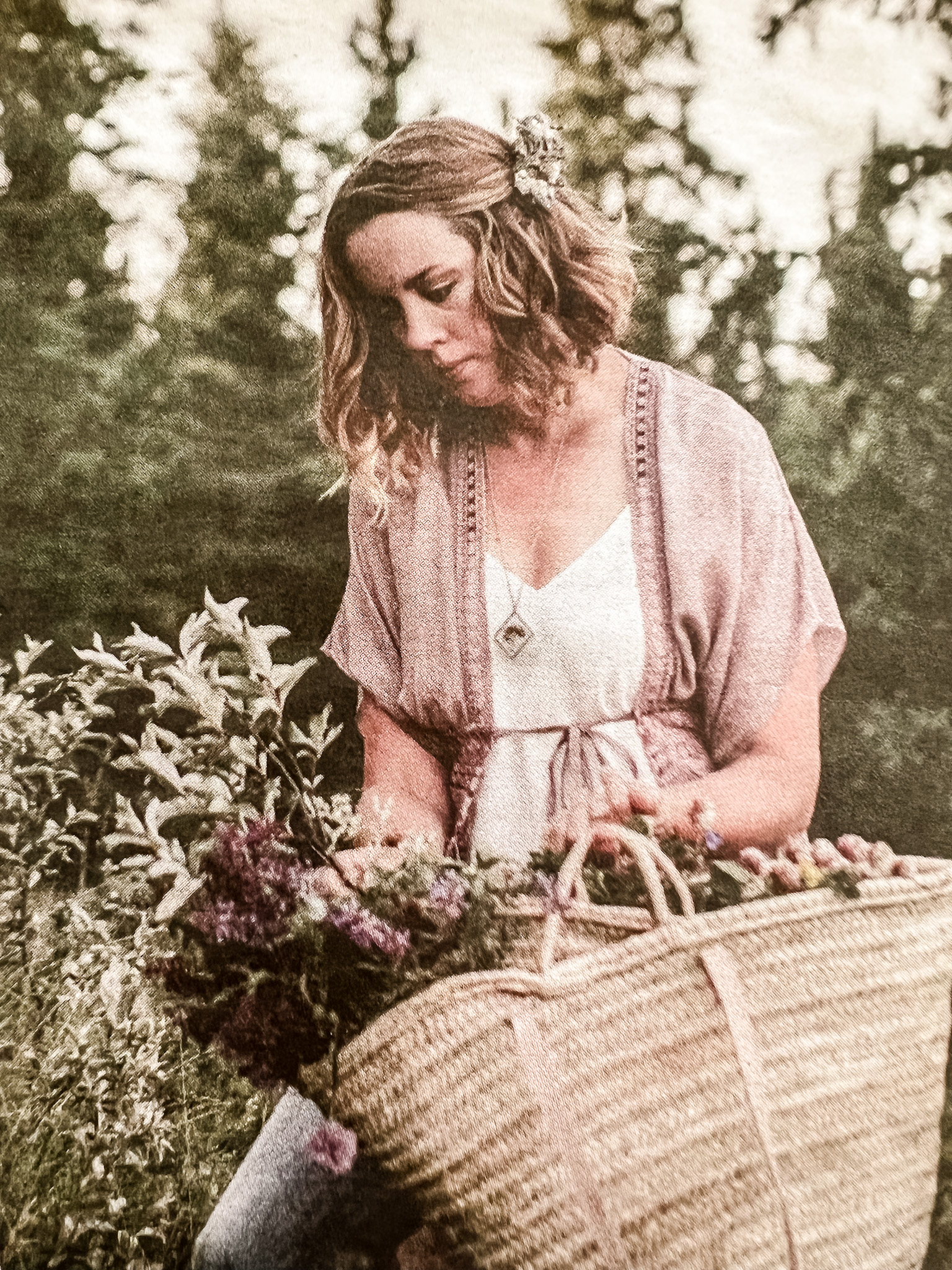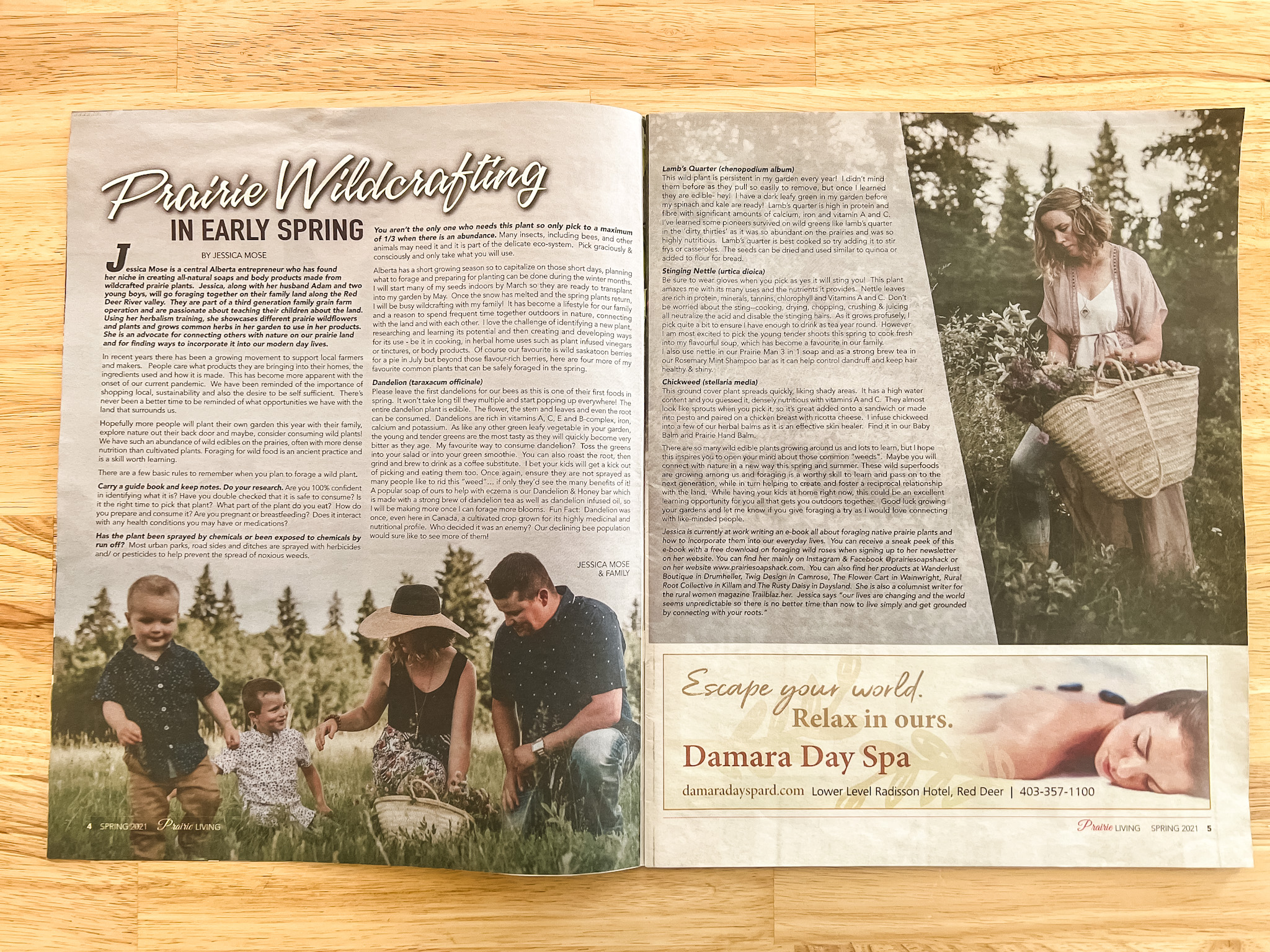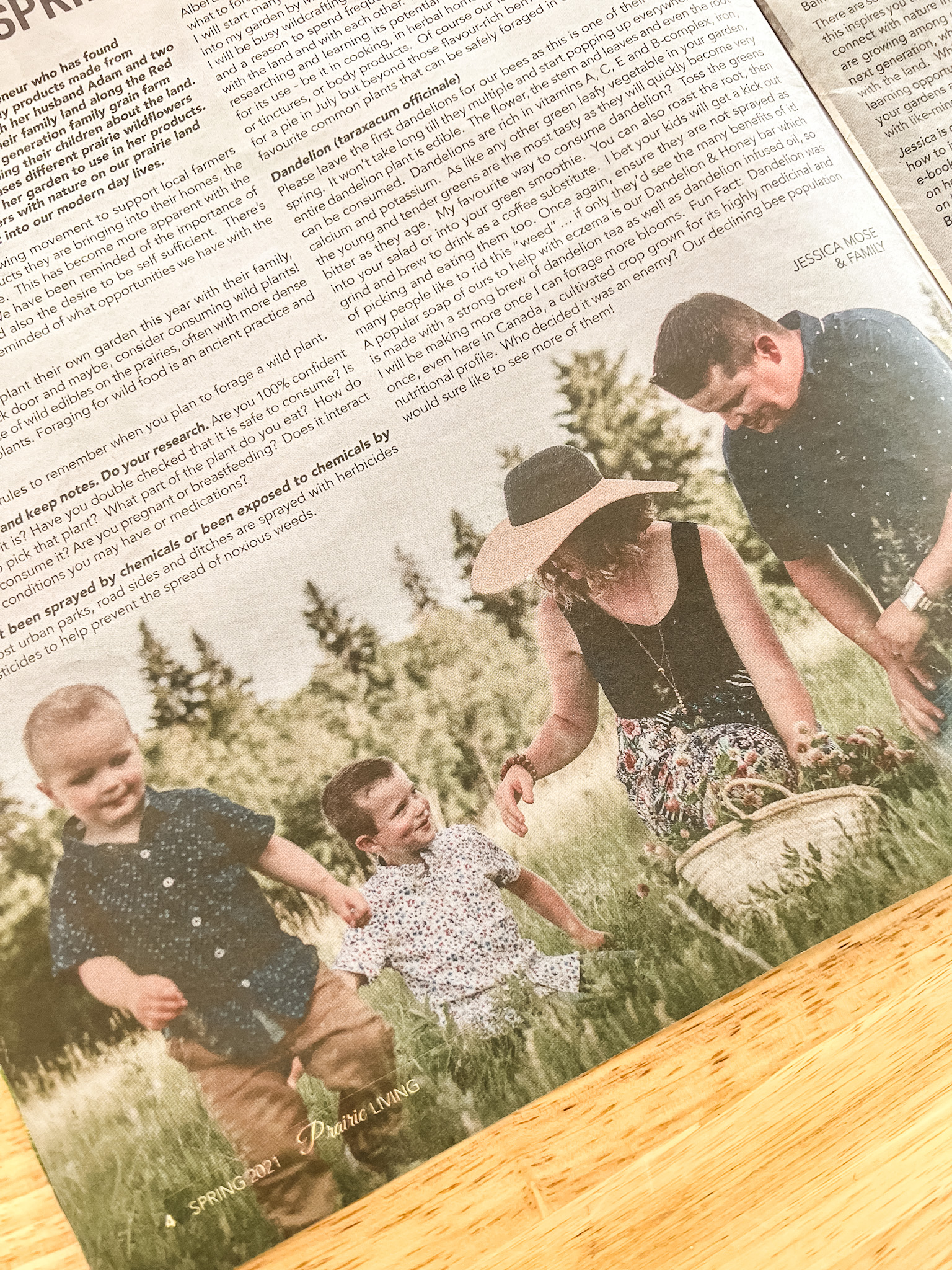The central Alberta magazine featured us in Spring 2021 by having us on the cover of the magazine and with our feature article "Prairie Wildcrafting". We explore common wild plants, how to forage for them and simple ways we use them.
We were honoured to be featured and hope you enjoy the article from this publication!
Jessica Mose is a central Alberta entrepreneur who has found her niche in creating all-natural soaps and body products made from wildcrafted prairie plants. Jessica, along with her husband Adam and two young boys, will go foraging together on their family land along the Red Deer River valley. They are part of a third generation family grain farm operation and are passionate about teaching their children about the land. Using her herbalism training, she showcases different prairie wildflowers and plants and grows common herbs in her garden to use in her products. She is an advocate for connecting others with nature on our prairie land and for finding ways to incorporate it into our modern day lives.
In recent years there has been a growing movement to support local farmers and makers. People care what products they are bringing into their homes, the ingredients used and how it is made. This has become more apparent with the onset of our current pandemic. We have been reminded of the importance of shopping local, sustainability and also the desire to be self sufficient. There’s never been a better time to be reminded of what opportunities we have with the land that surrounds us.
Hopefully more people will plant their own garden this year with their family, explore nature out their back door and maybe, consider consuming wild plants! We have such an abundance of wild edibles on the prairies, often with more dense nutrition than cultivated plants. Foraging for wild food is an ancient practice and is a skill worth learning.
There are a few basic rules to remember when you plan to forage a wild plant.
- Carry a guide book and keep notes. Do your research.
- Are you 100% confident in identifying what it is?
- Have you double checked that it is safe to consume?
- Is it the right time to pick that plant?
- What part of the plant do you eat? How do you prepare and consume it?
- Are you pregnant or breastfeeding? Does it interact with any health conditions you may have or medications?
- Has the plant been sprayed by chemicals or been exposed to chemicals by run off? Most urban parks, road sides and ditches are sprayed with herbicides and/ or pesticides to help prevent the spread of noxious weeds.
- You aren’t the only one who needs this plant so only pick to a maximum of 1/3 when there is an abundance. Many insects, including bees, and other animals may need it and it is part of the delicate eco-system. Pick graciously & consciously and only take what you will use.
Alberta has a short growing season so to capitalize on those short days, planning what to forage and preparing for planting can be done during the winter months. I will start many of my seeds indoors by March so they are ready to transplant into my garden by May. Once the snow has melted and the spring plants return, I will be busy wildcrafting with my family! It has become a lifestyle for our family and a reason to spend frequent time together outdoors in nature, connecting with the land and with each other. I love the challenge of identifying a new plant, researching and learning its potential and then creating and developing ways for its use - be it in cooking, in herbal home uses such as plant infused vinegars or tinctures, or body products. Of course our favourite is wild saskatoon berries for a pie in July but beyond those flavour-rich berries, here are four more of my favourite common plants that can be safely foraged in the spring.

- Dandelion (taraxacum officinale)
Please leave the first dandelions for our bees as this is one of their first foods in spring. It won’t take long till they multiple and start popping up everywhere! The entire dandelion plant is edible. The flower, the stem and leaves and even the root can be consumed. Dandelions are rich in vitamins A, C, E and B-complex, iron, calcium and potassium. As like any other green leafy vegetable in your garden, the young and tender greens are the most tasty as they will quickly become very bitter as they age. My favourite way to consume dandelion? Toss the greens into your salad or into your green smoothie. You can also roast the root, then grind and brew to drink as a coffee substitute. I bet your kids will get a kick out of picking and eating them too. Once again, ensure they are not sprayed as many people like to rid this “weed”… if only they’d see the many benefits of it! A popular soap of ours to help with eczema is our Dandelion & Honey bar which is made with a strong brew of dandelion tea as well as dandelion infused oil, so I will be making more once I can forage more blooms. Fun Fact: Dandelion was once, even here in Canada, a cultivated crop grown for its highly medicinal and nutritional profile. Who decided it was an enemy? Our declining bee population would sure like to see more of them!
- Lamb’s Quarter (chenopodium album)
This wild plant is persistent in my garden every year! I didn’t mind them before as they pull so easily to remove, but once I learned they are edible- hey! I have a dark leafy green in my garden before my spinach and kale are ready! Lamb’s quarter is high in protein and fibre with significant amounts of calcium, iron and vitamin A and C. I’ve learned some pioneers survived on wild greens like lamb’s quarter in the ‘dirty thirties’ as it was so abundant on the prairies and was so highly nutritious. Lamb’s quarter is best cooked so try adding it to stir frys or casseroles. The seeds can be dried and used similar to quinoa or added to flour for bread.
- Stinging Nettle (urtica dioica)
Be sure to wear gloves when you pick as yes it will sting you! This plant amazes me with its many uses and the nutrients it provides. Nettle leaves are rich in protein, minerals, tannins, chlorophyll and Vitamins A and C. Don’t be worried about the sting--cooking, drying, chopping, crushing & juicing all neutralize the acid and disable the stinging hairs. As it grows profusely, I pick quite a bit to ensure I have enough to drink as tea year round. However I am most excited to pick the young tender shoots this spring to cook fresh into my flavourful soup, which has become a favourite in our family.
I also use nettle in our Prairie Man 3 in 1 soap and as a strong brew tea in our Rosemary Mint Shampoo bar as it can help control dandruff and keep hair healthy & shiny.
- Chickweed (stellaria media)
This ground cover plant spreads quickly, liking shady areas. It has a high water content and you guessed it, densely nutritious with vitamins A and C. They almost look like sprouts when you pick it, so it’s great added onto a sandwich or made into pesto and paired on a chicken breast with ricotta cheese. I infuse chickweed into a few of our herbal balms as it is an effective skin healer. Find it in our Baby Balm and Prairie Hand Balm.
There are so many wild edible plants growing around us and lots to learn, but I hope this inspires you to open your mind about those common “weeds”. Maybe you will connect with nature in a new way this spring and summer. These wild superfoods are growing among us and foraging is a worthy skill to learn and pass on to the next generation, while in turn helping to create and foster a reciprocal relationship with the land. While having your kids at home right now, this could be an excellent learning opportunity for you all that gets you outdoors together. Good luck growing your gardens and let me know if you give foraging a try as I would love connecting with like-minded people.
Jessica is currently at work writing an e-book all about foraging native prairie plants and how to incorporate them into our everyday lives. You can receive a sneak peek of this e-book with a free download on foraging wild roses when signing up to her newsletter on her website. You can find her mainly on Instagram & Facebook @prairiesoapshack or on her website www.prairiesoapshack.com. You can also find her products at Wanderlust Boutique in Drumheller, Twig Design in Camrose, The Flower Cart in Wainwright, Rural Root Collective in Killam, Local Roots Flower & Design in Wetaskiwin and The Rusty Daisy in Daysland. She is also a columnist writer for the rural women magazine Trailblaz.Her. Jessica says “our lives are changing and the world seems unpredictable so there is no better time than now to live simply and get grounded by connecting with your roots.”
(Added March 4/22- our eBook Modern Wildcrafted is available for purchase on link below)






